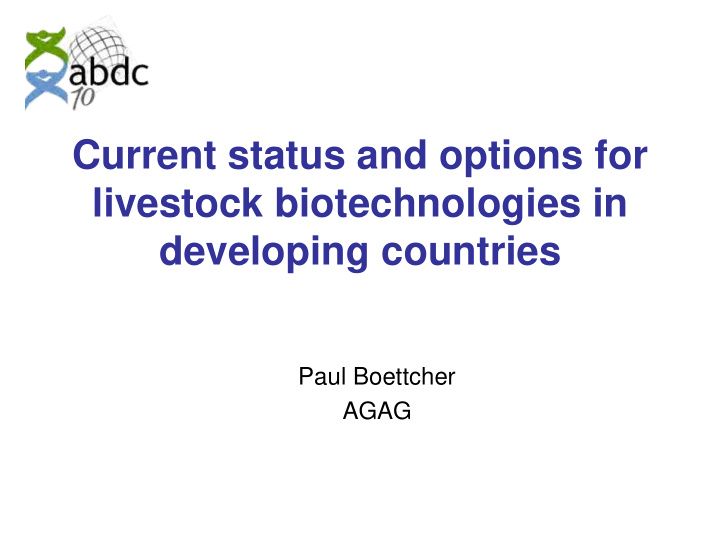



Current status and options for livestock biotechnologies in developing countries Paul Boettcher AGAG
Introduction • Livestock make a critical contribution to livelihoods of members of rural communities • “Livestock Revolution” expected to increase importance, especially in developing countries • Numerous challenges exist – environmental interaction, biodiversity, disease • Technology can help meet these challenges while increasing productivity
Stock Taking Learning from the Past • Wide range of technologies – conventional – biotechnology • Three Sectors – Animal reproduction and breeding – Animal nutrition and production – Animal health
Reproduction and Breeding • Artificial insemination – dissemination of superior male germplasm – opportunity for increased productivity • Complementary technologies – progesterone monitoring & oestrous synchronization – multiple ovulation and embryo transfer – sexing of semen and embryos • Molecular Genetics – characterization – marker assisted selection
Nutrition and Production • Use of micro-organisms – including recombinant DNA technology • Fermentation – produce amino acids or proteins – improve feed quality • Microbial cultures ↑ – quality of silage and digestibility of other feeds – pre- and probiotics • Recombinant bacteria – enzyme and hormone production • increased productivity or decreased environmental impact
Animal Health • Disease diagnosis – monoclonal antibodies: RIA and ELISA – molecular biology • more precision to distinguish infected from vaccinated • Vaccination – conventional – recombinant • increased specificity, stability and safety • Sterile insect technique – vector borne-diseases
Use: Reproduction and Breeding • AI most widely used – dairy cattle in peri-urban areas • lack of liquid N 2 for cryopreservation • exotic breeds rather than local – limited by lack of breeding programmes • Limited Embryo Transfer – inability to identify superior females • Molecular genetics – primarily characterization
Use: Nutrition and Production • Limited documentation • Amino acids and enzymes seem to be the most widely used – Local industries in China and India • Limiting factors – Silage innoculants: little silage production – Somatotropin: public acceptance – Fermentation: ineffectiveness
Use: Animal Health • Serological diagnosis widely used • Molecular diagnosis increasing – specific institutions and laboratories • Vaccination widely and successfully used – example: near eradication of rinderpest – largely conventional • Sterile Insect Technique – Tsetse fly in Zanzibar – Screw worms in various countries
Reasons for Success Complementary factors in place • Technical capacity • Institutional support and cooperation • Other technologies – animal health and nutrition • Availability to markets – sell increased production – support investment in the technologies
Looking Forward Preparing for the Future • New disease challenges – climate change and range of vectors ↑ – increased international trade • Climate change and environmental degradation – biotechnologies can decrease impact • Genetic diversity – characterize and improve local stocks – cryoconservation
Options for Developing Countries • Biotechnologies should build upon existing conventional technologies • Biotechnologies should be integrated with other relevant components of livestock production • Application of biotech should be supported within a national livestock development programme – problem-based, not solution-based • Appropriate models are needed to ensure accessibility by resource poor farmers
The Role of the International Community • Framework for international cooperation • Financial support for generation, adaptation and adoption of technologies • Public-private partnerships to increase uptake • Creation and maintenance of markets for end products
The Role of the International Community • Provide support for management of animal genetic resources – including policy development • Collaboration for improved disease diagnosis – zoonoses • Establishment of disease reference laboratories
The Role of the International Community • Integration of biotech within overall national livestock development programmes – with respect to wider development objectives • Improved international cooperation – North-South – South-South • Consistent and long-term funding – aim toward self-sustainability
The Role of the International Community • Increased support for R&D in animal science • Training of personnel in quality research – prerequisite for harnessing benefits • Strengthen institutions of higher learning – improve intellectual basis for identifying problems and proposing solutions • Public awareness of biotechnologies should be enhanced by providing science-based information regarding their efficacy, safety, costs and benefits in the development context
SHORT NAME OF SESSION ROLES EXPECTED OUTCOMES J.A.: Facilitator E.G.: Host AGENDA • To better understand T.N.: Panelist 1 the issue, identify W.D.: Panelist 2 14.30 Welcome & gaps and needs... C.R.: Rapporteur introduction All others: Participants • To identify options 14.40 Panel talk show for the future... 15.20 Discussion with • To have content for audience summary for next 16.10 Closing days plenary 16.15 Coffee RULES • Participate and share experiences • Keep focus on key issues • No one dominates • Respect the time Introduction of parallel session
Recommend
More recommend